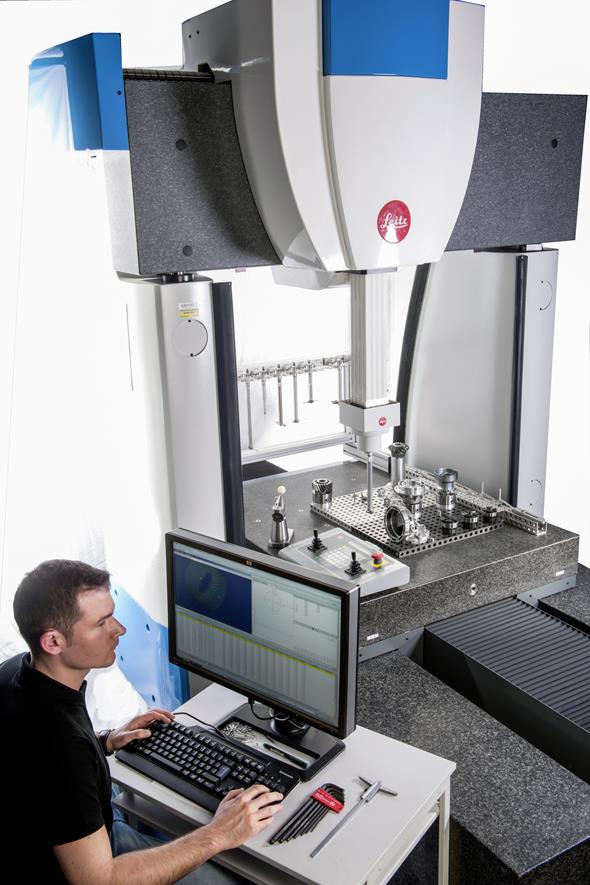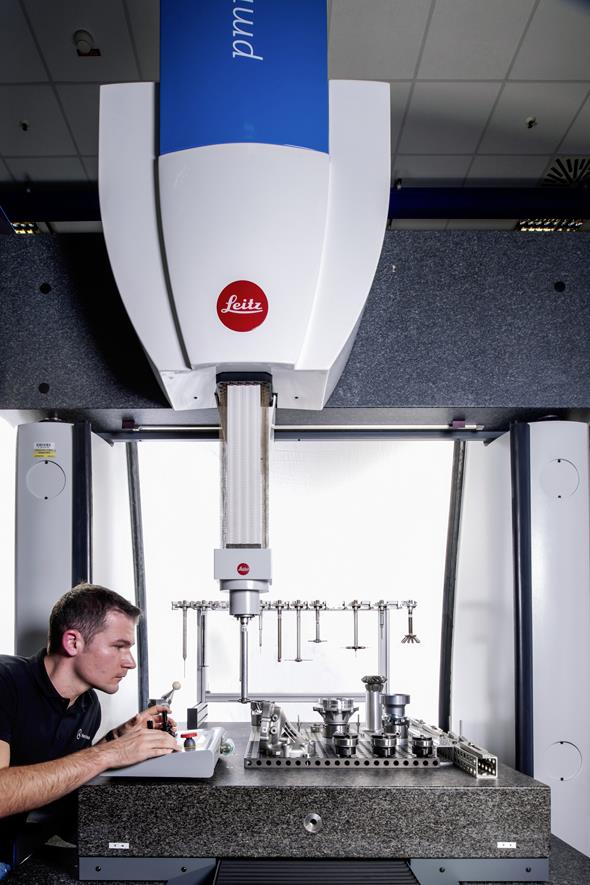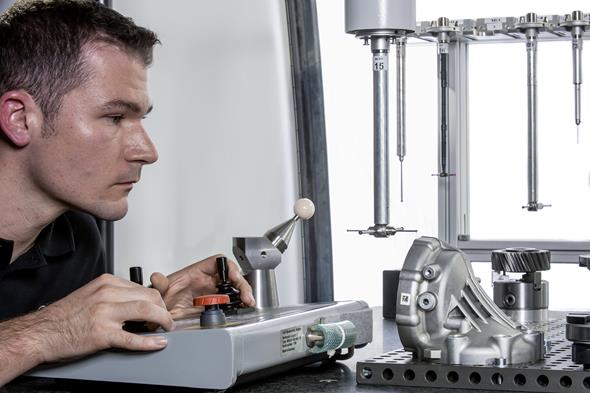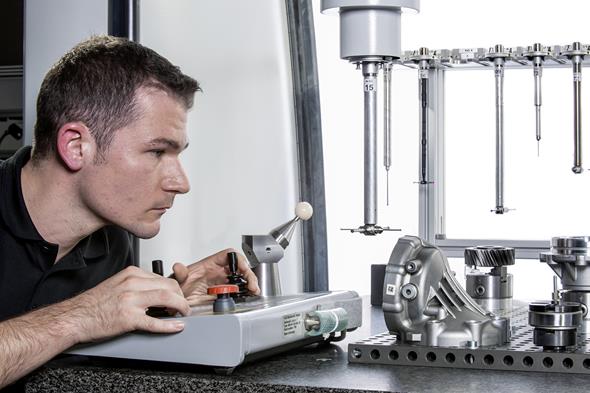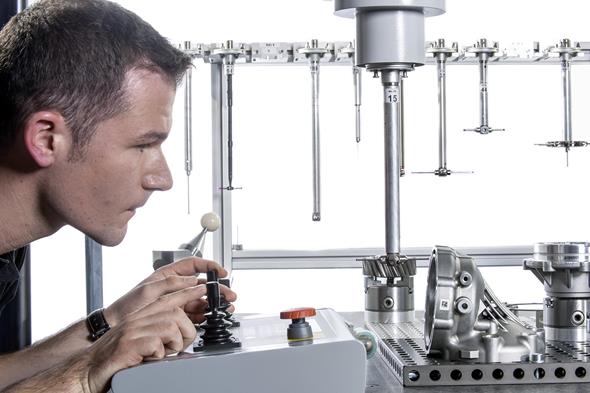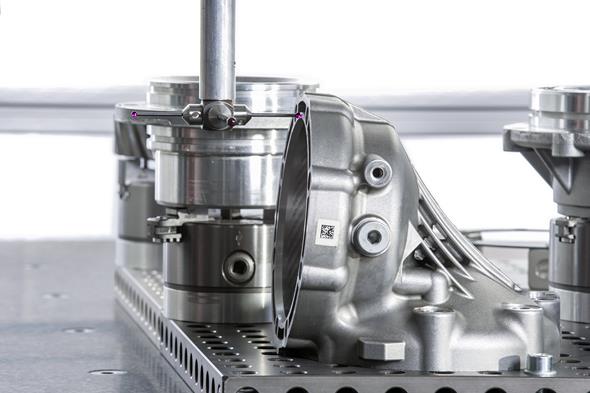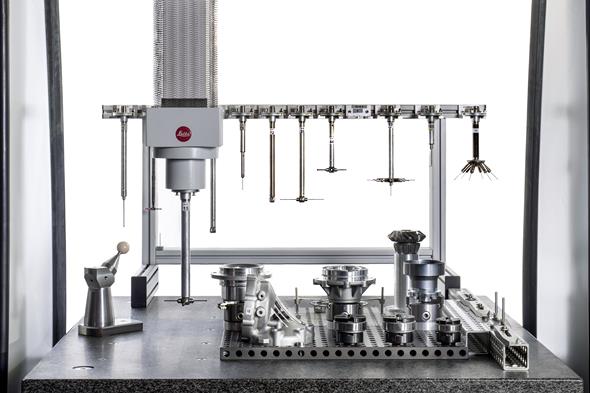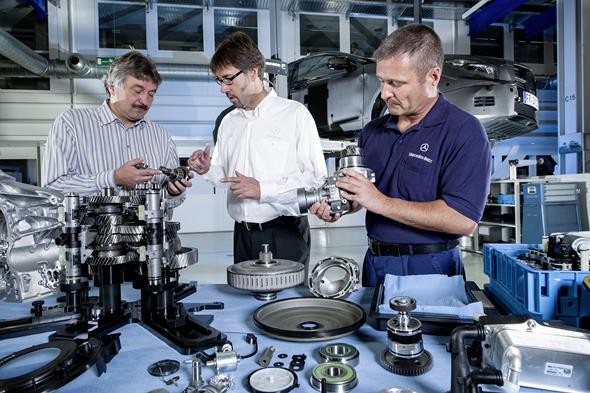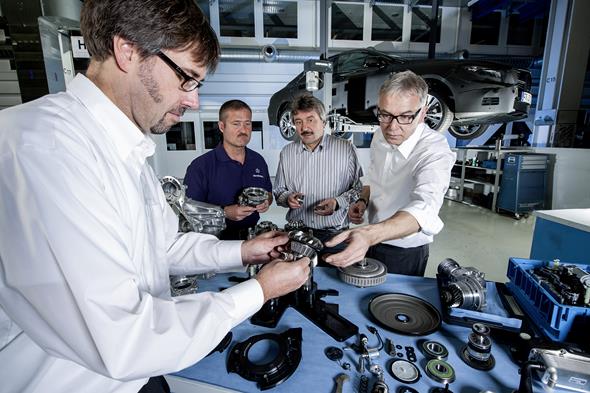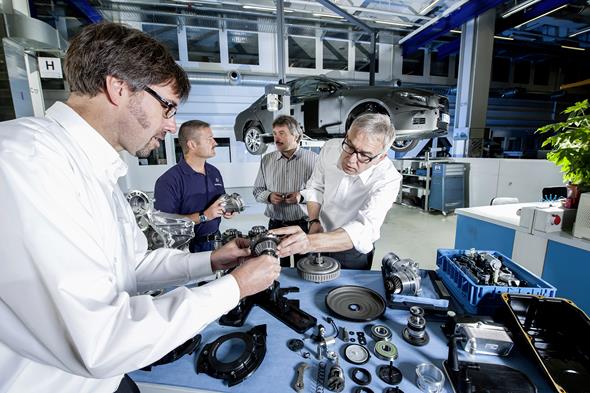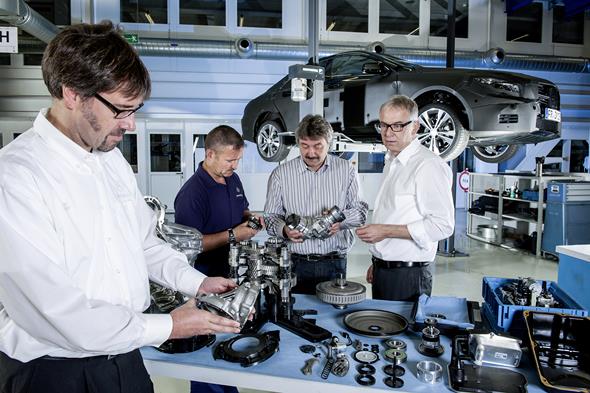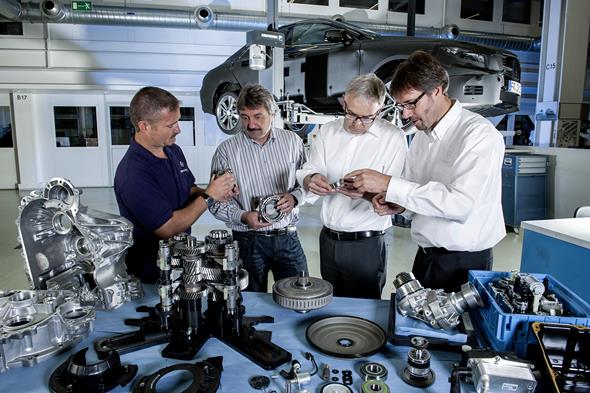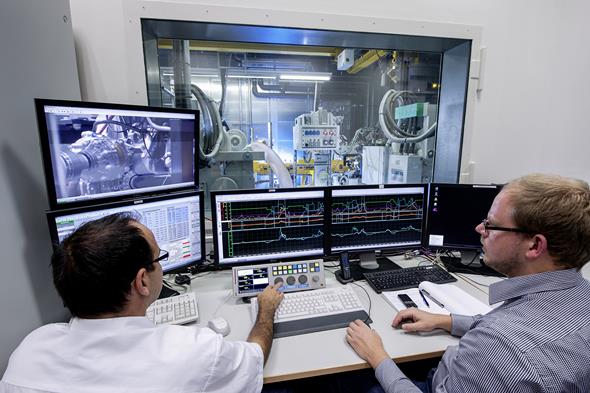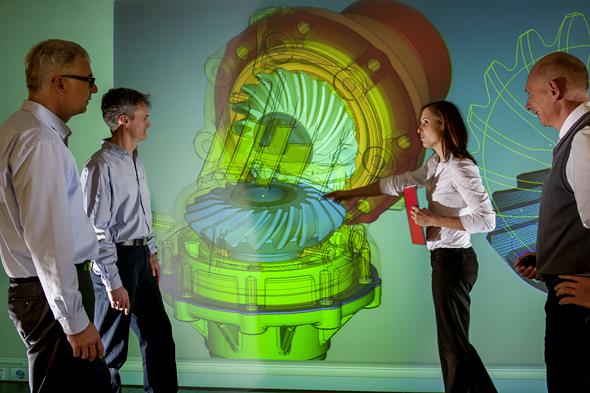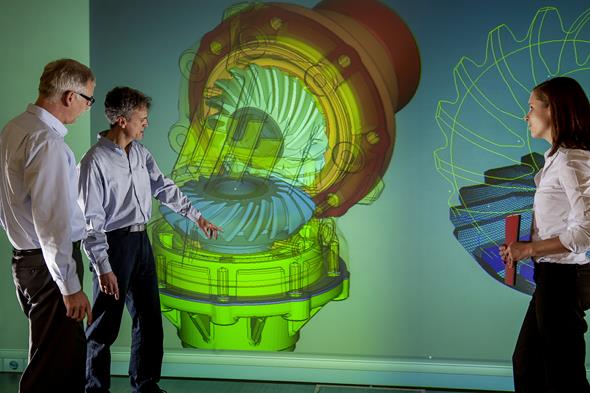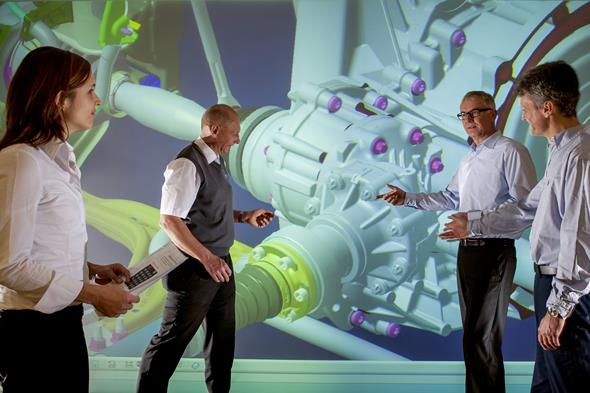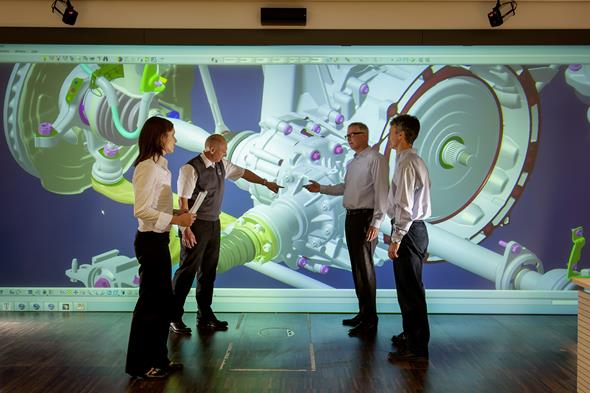The summit of perfection with new 4MATIC

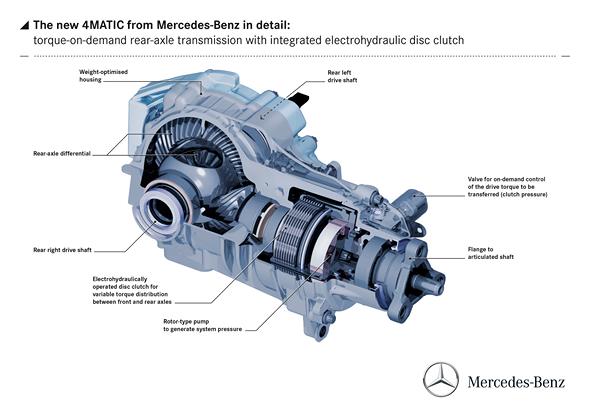
All-wheel drive for all – tailor-made solutions
Stuttgart/Hochgurgl. From next year, Mercedes-Benz will be offering a new generation of the 4MATIC permanent all-wheel drive system with fully variable torque distribution. This totally new development is based on the front-wheel drive architecture with transversely mounted engines.
Like the other 4MATIC versions, it boasts high tractive power reserves and outstanding agility accompanied by optimum driving safety and energy efficiency. The new 4MATIC will complement the four all-wheel drive versions which have been available to date.
This will ensure 4×4 technology tailored to the respective vehicle categories – from the new compact class and the models of the C-, E-, S-, CLS- and CL-Class to the comprehensive range of SUVs and ATVs covering the GLK-, M-, GL-Class and G-Class.
The new 4MATIC will also boost driving enjoyment in the two particularly dynamic Mercedes-Benz CLA and CLA 45 AMG models. Both of these models will be premiered in 2013.
The most innovative components of the new 4MATIC include the power take-off to the rear axle which is integrated in the 7G-DCT automated dual clutch transmission and the rear-axle gear unit with integrated, electrohydraulically controlled multi-disc clutch.
This set-up enables fully variable distribution of the drive torque between front and rear axle. Additional benefits of this design are a lower system weight than is available from the competition and high efficiency. Similarly to the front-wheel drive versions, all 4MATIC models also boast good energy efficiency.
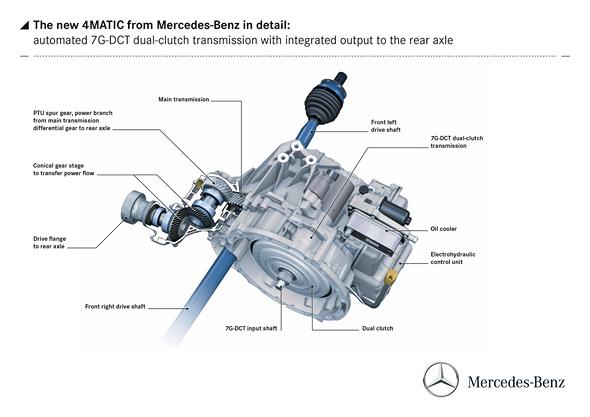
The 4MATIC all-wheel drive is a completely new development tailored to the requirements of the new models with front-wheel drive. The future all-wheel drive line-up from Mercedes-Benz will be heralded in the coming year by the CLA-Class and the particularly agile and powerful CLA 45 AMG. While the technical basis is identical on all versions, the AMG models feature a modified power output to the rear axle.
Integrated power take-off unit (PTU) channels power to the rear axle
The new 4MATIC is being combined with the 7G-DCT seven-speed automated dual clutch transmission which was premiered in the B-Class. The power flux to the rear powertrain is provided by a compact power take-off unit (PTU) which is fully integrated in the main transmission and is supplied with lubricant from the latter’s oil circuit.
This configuration gives rise to substantial weight advantages in comparison to rival systems which branch off power by means of an add-on component with its own oil circuit. Together with the friction-minimised tapered roller bearings, the PTU achieves an excellent level of efficiency.
The low system weight of the new 4MATIC is not attributable solely to the PTU. Other weight-stripping measures include a compact rear-axle gear unit, inductively hardened rear-axle side shafts in hollow design and weight-optimised propeller shafts. The system weight of the new 4MATIC is up to 25 percent lighter than the all-wheel drive versions offered by the competition.
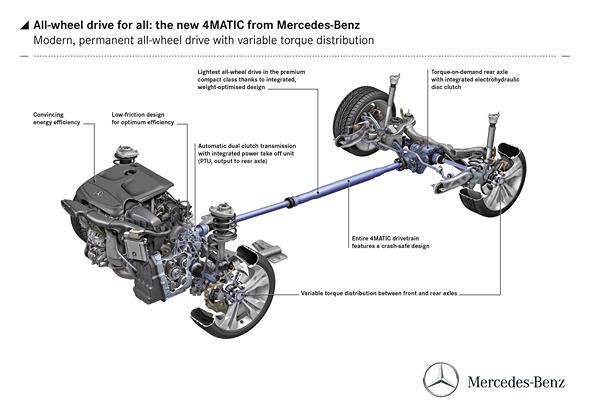
The two-part cardan shaft is vibrationally decoupled, with an axially moving joint at the front compensating the movements of the engine-transmission unit and preventing transfer to the rear powertrain. To minimise crash-induced stress, the cardan shaft is fitted with a crash joint.
Completely new development with torque-on-demand rear axle
The electrohydraulically actuated multi-disc clutch integrated in the rear axle gear unit is responsible for fully variable torque distribution. Operating principle: when the multi-disc clutch is open, the CLA is driven almost exclusively by the front axle.
When the clutch is closed, the rear axle comes into play. This means that the drive torque can be shifted in fully variable mode between front and rear axle according to the given situation (torque on demand).
The system pressure to activate the rear axle is supplied in milliseconds by the rotor-type pump which is integrated in the rear-axle gear unit. The pump is activated automatically as soon as only minimal speed differences apply between front and rear axle. Pressure control is performed by a proportioning valve under the steering of the ESP®.
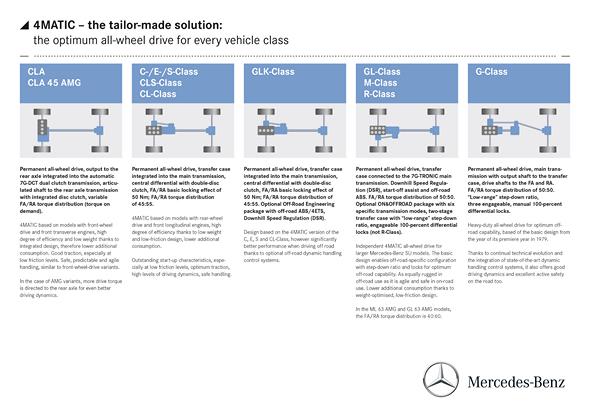
Intelligent control systems for more enjoyable driving
The 4MATIC is activated according to the basic principle of “as often as necessary, as rarely as possible”. This means that when the underlying conditions allow, the all-wheel drive CLA models run almost exclusively in particularly economical front-wheel drive mode. As soon as the driving situation requires, drive torque is channelled to the rear axle as appropriate.
The reverse process takes place just as quickly: as soon as additional drive torque is no longer necessary at the rear axle – e.g. in case of heavy braking manoeuvres with ABS intervention – the rear powertrain is deactivated and torque is reduced to zero.
In case of understeering or oversteering under load, the drive torque is first of all distributed such as to stabilise the vehicle. Only if these measures fail to have a stabilising effect do the control systems adapted to 4MATIC conditions, such as ESP® or 4ETS, intervene to keep the CLA stable.
With this strategy, the developers have managed to combine two key requirements defined in the performance specifications: optimum energy efficiency coupled with maximum driving dynamics and driving safety.
Individual: driving modes to suit personal driving styles
The torque distribution ratio is also dependent on the activated shift programme of the 7G-DCT dual clutch transmission. The ECO programme results in torque distribution of a conservative nature. Less torque is channelled to the rear axle, resulting in gentler handling and supporting an economical driving style at lower revs.
In SPORT or MANUAL mode the activation times are shortened and more torque is distributed to the rear axle in the interests of a dynamic, sporty driving style. On the AMG versions, adaptation of the 4MATIC controller takes place in accordance with the 3-stage ESP®.
New 4MATIC featuring in the Mercedes-Benz CLA
The future all-wheel-drive line-up from Mercedes-Benz will be heralded in the coming year by the CLA-Class and the particularly agile and powerful CLA 45 AMG.
The new Mercedes-Benz CLA adopts the avant-garde design of the Concept Style Coupé into series production almost 1:1. In keeping with its sporty positioning, the CLA is available with high-torque turbo engines rated at up to 155 kW (211 hp), sports suspension and the newly developed 4MATIC. The technical highlights include numerous driving assistance systems, such as advanced COLLISION PREVENTION ASSIST.
CLA 45 AMG: the most dynamic way to experience the new 4MATIC
As the high-powered top model of the new compact class, the CLA 45 AMG broadens the portfolio of Mercedes-Benz’s high-performance brand to offer a fascinating high-performance vehicle in this class, too.
The newly developed AMG 2.0-litre four-cylinder turbo petrol engine will set new standards in its engine capacity segment: with maximum torque of well over 400 Newton metres and low fuel consumption, AMG is aiming to lead the competition.
In conjunction with the specially adapted 4MATIC version for this engine-power class, the CLA 45 AMG will be one of the most dynamic, powerful and efficient four-cylinder series-production compact cars.
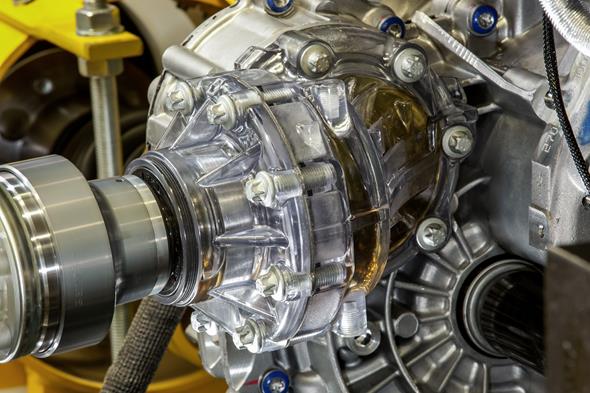
Elegant in all weathers: the CLS Shooting Brake 4MATIC
The CLS Shooting Brake sees Mercedes-Benz making its mark once again with a creative design concept that underscores its leading role in the design field.
Surprising yet unequivocally coupé, the CLS Shooting Brake’s proportions create a crouched posture, as if the vehicle were poised to make a leap: long bonnet, narrow window profile with frameless side windows, roof sloping dynamically towards the rear and continuing to the tail end of the vehicle.
Only at second glance does it become clear that the Shooting Brake actually has five doors and offers more in terms of functionality. In essence it represents an unprecedented version of a sports car with five seats and a large tailgate.
Like all 4MATIC models from Mercedes-Benz, the high-powered and high-torque CLS 350 CDI 4MATIC (195 kW/265 hp, 620 Nm) and CLS 500 4MATIC (300 kW/408 hp, 600 Nm) feature a permanent all-wheel drive system which guarantees optimum traction and the best possible agility and safety – particularly in wintry road conditions.
New GL- and GLK-Class all set for their first winter
The new GL-Class which is available from November 2012 is the pinnacle of perfection in the ATV and SUV world. It offers a luxurious interior with seven full-size seats and superlative ride comfort accompanied by highly dynamic performance on dry, wet or wintry roads.
The premium SUV also boasts outstanding off-road capabilities, thanks to new suspension developments and innovative dynamic handling control systems which enhance both driving pleasure and safety on the road. In a nutshell, the GL-Class is a seven-seater, all-terrain S-Class.
The optional ON&OFFROAD package for the GL-Class uses six different driving modes to optimise driving dynamics and handling safety by providing the optimum drive control needed to cope with the wide spectrum of operating conditions encountered both on and off road.
Drivers have the choice of an automatic mode, two specially programmed off-road modes as well as three on-road modes – “Winter”, “Sport” and “Towing”. The winter driving mode of the ON&OFFROAD package improves handling on glazed frost, snow and ice or when using snow chains and offers additional safety.
When the ON&OFFROAD package is combined with another optional feature, the ACTIVE CURVE SYSTEM, a specially programmed winter set-up offers dynamic driving pleasure while giving the driver excellent control over the vehicle for a high degree of handling safety.
At the same time, the system is capable of giving the GL-Class greater traction, especially in wintry road conditions with low grip levels. What’s more, this set-up boasts even greater directional stability in tighter corners thanks to a special control algorithm that is programmed into the system.
April witnessed the premiere of the second new SUV to be launched in 2012: the revamped GLK-Class from Mercedes-Benz. This SUV is now able to demonstrate its outstanding capabilities in wintry conditions, too.
Its claim to leadership of the compact SUV segment is underscored by trailblazing assistance systems, engines matching efficiency with agility, a new design and an extended range of equipment and appointments.

The 4MATIC on the GLK is based on the version featuring on the C-, E-, CLS- and S-Class, whereby its outstanding off-road capability sets it apart from the saloons and coupés, however. For keen off-road enthusiasts, an Offroad Engineering package is additionally available to further broaden the scope for off-road adventures.
At the touch of a button a special drive programme is started which varies the shift points of the 7G-TRONIC, “softens” the accelerator characteristics and activates the ESP® off-road functions with off-road ABS and a special off-road 4ETS system. An additional switch activates Downhill Speed Regulation (DSR).
Even the best all-wheel drive is no substitute for winter tyres
Like any other all-wheel drive system, the 4MATIC versions have to abide by the laws of driving physics. The fundamental rule is that a tyre is only able to transfer a certain level of overall force to the road surface. If a particularly high degree of longitudinal force is required during acceleration or braking, for example, the available lateral force is reduced.
When cornering, the reverse applies: now a large amount of lateral force is required to keep the vehicle on course, while the longitudinal force potential is restricted. The engineers’ skill in designing the drive mechanism and fine-tuning the control systems lies in their ability to exploit these correlations in such a way as to ensure the best possible handling characteristics under all conditions.
The frictional coefficient µ describes the physical grip between the tyres and the ground. This figure is high on a dry road (µ = 0.9) and low on a snow-covered road (µ = 0.3).
Despite all the engineers’ efforts, it is ultimately the drivers themselves who determine how safe they are out on the road. They should always adapt their driving style in accordance with the prevailing wintry conditions and ensure that their vehicle is suitably equipped; winter tyres are absolutely essential here.
The full works: the 4MATIC range from Mercedes-Benz
In addition to the described models, the 4MATIC range also extends to the saloon and estate versions of the E- and C-Class, the luxurious S-Class, the CL luxury coupé, the four-door CLS Coupé and the R-Class.
The M-Class and the legendary G-Class round off the range in the SUV and ATV segment. The all-wheel drive line-up from Mercedes-Benz also includes an exotic model in the guise of the SLS AMG Electric Drive.
Four electric motors on this vehicle guarantee tremendous thrust, with fully variable and selective drive torque distribution to the individual wheels. In all, the 4MATIC range currently comprises 51 models.
And when the compact models featuring the new 4MATIC generation round off the range next year, it will really be a case of all-wheel drive all-round! The 4×4 family from Mercedes-Benz will then cover almost 60 models.
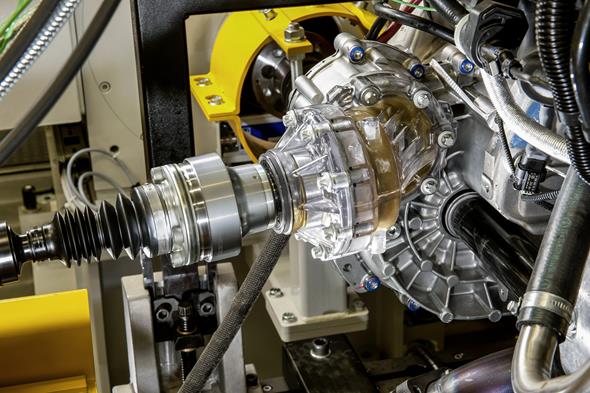
4MATIC for the compact model range from Mercedes-Benz
Greater driving dynamics, greater traction, greater safety
- Fully variable permanent all-wheel drive for the front-wheel vehicles
- Dual clutch transmission with integrated power take-off
- Torque on demand-rear axle
- Intelligent control systems for safer and more enjoyable driving
- Different modes to suit personal driving styles
The most innovative components of the new 4MATIC include the power take-off to the rear axle which is integrated in the 7G-DCT automated dual clutch transmission and the rear-axle gear with integrated, electrohydraulically controlled multi-disc clutch.
This set-up enables fully variable distribution of the drive torque between front and rear axle. Additional benefits of this design are a lower system weight than is available from the competition and high efficiency.
The 4MATIC all-wheel drive is a completely new development tailored to the requirements of the new front-wheel drive architecture. The engineers at Mercedes-Benz have ventured into uncharted territory here, as the design of the previous model series ruled out the introduction of an all-wheel drive system based on a front-wheel drive architecture with transversely mounted front engines.
On these previous models the differential was located in front of the engine in the direction of travel, thus thwarting any options of diverting drive power to the rear axle. In addition, the body design with sandwich floor prevented the integration of a cardan shaft to the rear axle.
For the new front-wheel drive vehicles, adequate installation space for an all-wheel drive powertrain was provided right from the initial stages of the planning process. In addition, the development engineers designed the powertrain such that the differential axle is situated behind the engine, thus enabling power to be branched off to the rear axle.
The future all-wheel drive line-up from Mercedes-Benz will be heralded in the coming year by the new CLA and the particularly agile and powerful CLA 45 AMG. While the basic mechanical configuration is identical on all versions, the AMG models feature a modified power output to the rear axle.
Integrated power take-off unit (PTU) channels power to the rear axle
The new 4MATIC is being combined with the 7G-DCT seven-speed automated dual clutch transmission which was premiered in the B-Class. The power flux to the rear powertrain is provided by a compact power take-off unit (PTU) which is fully integrated in the main transmission and is supplied with lubricant from the latter’s oil circuit.
This configuration gives rise to substantial weight advantages in comparison to rival systems which branch off power by means of an add-on component with its own oil circuit. Together with the friction-minimised tapered roller bearings, the PTU achieves an excellent level of efficiency.
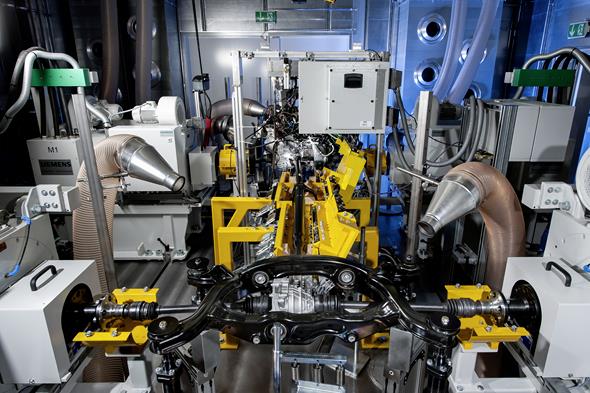
The low system weight of the new 4MATIC is not attributable solely to the PTU. Other weight-stripping measures include a compact rear-axle gear unit, inductively hardened rear-axle side shafts in hollow design and weight-optimised propeller shafts.
The system weight of the new 4MATIC is up to 25 percent lighter than the all-wheel-drive versions offered by the competition. These lightweight design measures and the high functional efficiency result in a good level of energy efficiency.
As is always the case with all-wheel drive systems incorporating a transversely mounted drive unit at the front, the power flux requires to be diverted by 90 degrees. On the 4MATIC, this is achieved by quite simple means: the differential gearwheel of the main transmission drives the spur gear of the PTU and a compact bevel gear stage diverts the power flux.
The rear axle is driven via an output flange and a cardan shaft.
A vibrationally decoupled intermediate bearing is fitted between the two-part cardan shaft and underbody and a flexible coupling is installed between the shaft and the rear-axle gear unit. An axially moving joint at the front compensates the typical movements of the engine-transmission unit under load and prevents the transfer of such movements to the rear powertrain.
By virtue of these measures, all the 4MATIC versions attain a level of NVH comfort on a par with that of the comparable models with front-wheel drive. In order to minimise crash-induced stress for passengers in a head-on or rear-end collision, the cardan shaft is provided with a crash joint.
Here again, the 4MATIC models attain a standard of safety on a par with that of the front-wheel drive models.
Completely new development with torque-on-demand rear axle
The electrohydraulically actuated multi-disc clutch integrated in the rear-axle gear unit is responsible for fully variable torque distribution. Operating principle: when the multi-disc clutch is open, the CLA is driven almost exclusively by the front axle.
When the clutch is closed, the rear axle comes into play. This means that the drive torque can be shifted in fully variable mode between front and rear axle according to the given situation (torque on demand).
The system pressure to activate the rear axle is supplied in milliseconds by the rotor pump which is integrated in the rear-axle gear unit. The pump is activated automatically as soon as only minimal speed differences apply between front and rear axle. Pressure control is performed by a proportioning valve under the steering of the ESP®.

The most diverse parameters are taken into consideration here, such as lateral acceleration, steering angle, yaw rate, accelerator position, ABS control settings or the selected shift programme of the 7G-DCT dual clutch transmission.
An additional pressure regulating valve limits the drive torque at the rear axle to 750 Newton metres. Up to 1000 Newton metres are possible on the AMG version.
Intelligent control systems for more enjoyable driving
The 4MATIC is activated according to the basic principle of “as often as necessary as rarely as possible”. This means that when the underlying conditions allow the all-wheel drive CLA models run almost exclusively in front-wheel drive mode. As soon as the driving situation requires, additional drive torque is channelled to the rear axle as appropriate.
The reverse process takes place just as quickly: as soon as additional drive torque is no longer expedient at the rear axle – e.g. in case of heavy braking manoeuvres with ABS intervention – the rear powertrain is deactivated and torque is reduced to zero.
With this strategy, the developers have managed to combine two key requirements defined in the performance specifications: optimum energy efficiency coupled with maximum driving dynamics and driving safety.
In normal circumstances, the drive torque distribution between front and rear axle can be set from 100:0 to 50:50. In certain driving situations, such as when exceeding the µ-jump limit, higher levels of torque may be allocated to the rear axle to avoid unstable operating conditions. Here are some examples of torque distribution (front:rear in percent, approximate values):
● Full-load acceleration at approx. 50 km/h → 60:40
● Dynamic cornering under load → 50:50
● Exceeding the µ-jump limit → 10:90
● Heavy braking with ABS intervention → 100:00
Another basic principle of the 4MATIC system results in a further increase in driving dynamics, guaranteeing greater driving enjoyment without compromising driving safety. In case of understeering or oversteering under load, the drive torque is first of all distributed such as to stabilise the vehicle.
This ensures that traction and driving enjoyment are fully maintained in speedy driving on winding stretches of road. Only if these measures fail to have a stabilising effect do the control systems adapted to 4MATIC conditions, such as ESP® or 4ETS, intervene to keep the CLA stable.
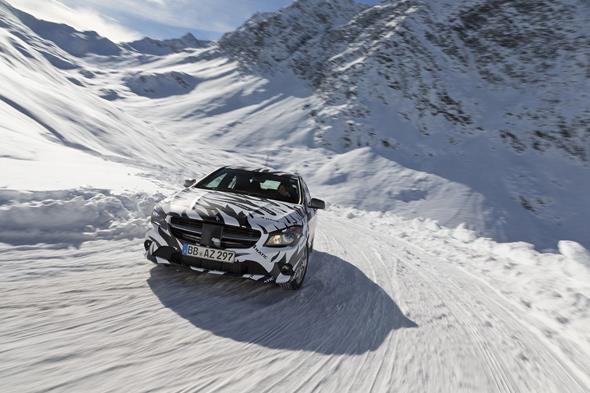
The 4ETS electronic traction system forms part of the ESP® electronic stability programme and brakes the driven wheels individually when they go into spin. This provides for a high level of traction on slippery surfaces, on roads which are icy on one side or in continually changing conditions.
In a nutshell: while 4ETS is responsible for maintaining the highest possible traction in all conditions, ESP® serves as the higher-level control instance to ensure optimum driving stability.
Individual: driving modes to suit personal driving styles
As already mentioned, the torque distribution ratio is also dependent on the activated shift programme of the 7G-DCT dual clutch transmission. The ECO programme results in torque distribution of a conservative nature. Less torque is channelled to the rear axle, resulting in gentler handling and supporting an economical driving style at lower revs.
In SPORT or MANUAL mode the activation times are shortened and more torque is distributed to the rear axle in the interests of a dynamic, sporty driving style.
On the AMG versions such as feature on the CLA 45 AMG, 4MATIC adaptation takes place in accordance with the 3-stage ESP® system, employing the user-selectable settings ESP ON, ESP SPORT Handling Mode and ESP OFF. This 3-stage stability programme is also applied to adapt the control strategies of the variable 4MATIC system.
The new AMG 4MATIC applies more rear-biased torque distribution as a general principle, in order to increase lateral dynamics around the vehicle’s vertical axis.

Detailed investigations in the testing phase
Alongside exact and realistic simulation using a digital prototype, extensive practical testing remains integral to the development phase of new models and drives. For the new 4MATIC, endurance testing and detailed tuning trials were carried out in all climatic zones and on all possible types of roads and surfaces.
The test engineers carried out their work at test sites beyond the Arctic Circle and in desert regions, as well as trials closer to home at the Daimler test sites in Papenburg and Boxberg. Fine tuning of the control systems took place on race tracks such as the legendary Nürburgring Nordschleife and demanding alpine passes.
The test programme was backed up with extensive trials under standardised conditions on the all-wheel drive test rigs in Stuttgart-Untertürkheim. The entire powertrain with engine is set up on these large-scale test rigs and subjected to punishing treatment around the clock, following previously recorded and digitised test routes.
Driving resistance is simulated here by four electric motors connected to the hubs of the respective wheels. This enables exact comparison of different design variants under standardised conditions without weather influences or changing road conditions, to reveal the best solution.
The test rig runs are also important for the purpose of tuning individual parameters. An example here is provided by the power take-off unit (PTU), which shares a common oil circuit with the main transmission in the interests of minimising component weight and maximising efficiency.
As the lubricant supply process cannot be simulated exactly using a computer model, the engineers have come up with an “x-ray trick”. They produce the housing in a robust, transparent material and install this “glass PTU” in the powertrain. HD cameras can then be used to provide a perfect view of the oil circuit during the subsequent runs on the test rig and optimisation measures can duly be carried out as necessary.
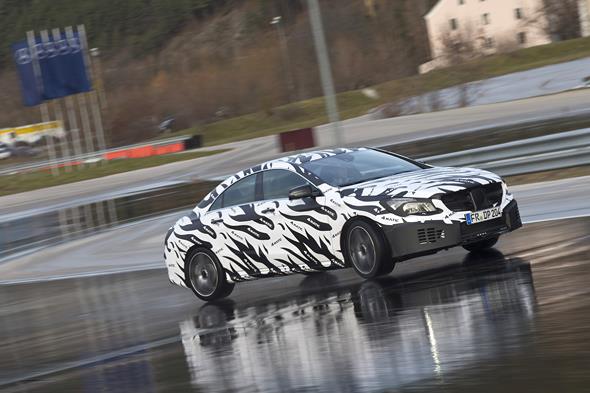
The above-described large-scale test rig demonstrates Daimler AG’s commitment to maximum environment-friendliness and resource conservation with regard to the design and operation of test facilities. The four electric motors function as generators during braking, feeding the recuperated energy back into the power grid – at Mercedes-Benz, recuperation is not limited to the vehicles themselves.
Perfect duo: new 4MATIC and 7G-DCT dual clutch transmission
Drawing on over 50 years of experience in the development and production of automatic transmissions, Mercedes-Benz has ventured into new technical territory with the 7G-DCT dual clutch transmission: the new system is an automated three-shaft manual transmission consisting of two subtransmissions, each with its own clutch. Both actuation of the clutches and gear shifting take place fully automatically and without any interruption in tractive power.
This enables a comfortable but nevertheless dynamic mode of driving. Thanks to its seven gears it offers a large gear ratio spread of up to 7.99. This means that a very short transmission ratio is available when moving off on an uphill slope with a high payload, for example, while during cruising the engine speed can be lowered considerably.
The transmission’s efficiency improves fuel economy by up to 9 percent in comparison to the CVT which has been employed in the A-Class to date, bringing fuel consumption down to a level below that obtained with a manual transmission.
At a length of 367 millimetres and a weight of 86 kilograms, the 7G-DCT is more compact and lighter than the transmissions in this torque class which have been available on the market to date. The clutches take the form of oil-cooled multi-disc clutches.
The specially developed hydraulic fluid is actively cooled, thus ensuring correct functioning of the transmission even under extreme conditions, despite the comparatively low filling level of six litres. Excess engine heat can also be transferred to the transmission, which improves its efficiency.
For the first time on this type of unit, the transmission is supplied with oil by two oil pumps – one mechanical and one electric. The electric pump maintains the oil pressure when the engine is switched off via the start/stop function. This means that the transmission is immediately operational when the engine is restarted and the vehicle can move off again without any delay.
In addition, the electric pump is able to support the mechanical pump when peak loads apply, enabling a more compact and efficient design for the mechanical pump.
Another new feature is electrical activation of the hydraulics for the parking lock, which is locked by mechanical means. This “park by wire” function enables the transmission selector lever to be positioned as desired: it is located in the form of a steering column lever on the right behind the steering wheel.
In combination with the electric parking brake, additional space has thus been created in the centre console for additional stowage facilities.
Three gearshift programmes are available to the driver:
- ECONOMY: in this mode, the transmission performs gearshifts fully automatically and particularly comfortably. The gears are selected with due regard to a particularly economical style of driving at low revs
- SPORT: the transmission performs gearshifts fully automatically. The shift and response times are shorter, with gearshifts at higher engine speeds
- MANUAL: in this mode, the driver operates the transmission manually via shift paddles behind the steering wheel. The engine speeds at which the gears are shifted can therefore be freely chosen
In ECO or SPORT mode, the driver is still able to intervene manually in the gear-shifting process via the shift paddles. The transmission reverts to the selected automatic mode after the paddles have remained inactive for ten seconds, or after a longer delay when driving downhill or on winding roads.
2013: premiere for CLA and CLA 45 AMGOn track of CLS and Co.
- Mercedes-Benz CLA: new model from the segment’s inventor
- Concept Style Coupé premiered in the spring becomes reality
- Avant-garde design coupled with high driving dynamics
- Mercedes-Benz CLA 45 AMG: elegant and athletic front runner
- New AMG 2.0-litre four-cylinder turbo petrol engine
- Superlative dynamism and efficiency
The new Mercedes-Benz CLA embodies in a production car the avant-garde design of the Concept Style Coupé which had its world premiere at the Auto China fair this April. The exciting compact mid-range coupé adopts the concept vehicle’s non-conformist, provocative and masculine lines.
On numerous points of detail the designers have drawn inspiration from the SLS and CLS modern Mercedes classics – examples being the sporty, self-assured front end, the powerdomes on the bonnet or the three-dimensional side design featuring an additional brawny muscle extending over the dropping line from the rear door to the boot lid.
In keeping with its sporty positioning, the CLA is available with high-torque turbo engines rated at up to 155 kW (211 hp), sports suspension and the newly developed 4MATIC. The technical highlights of the new design icon include numerous driving assistance systems, such as advanced COLLISION PREVENTION ASSIST PLUS.
In addition to outputting visual and acoustic warnings when an impending danger of a rear-end collision is identified, the latter system is also able to carry out autonomous partial braking if the driver fails to respond to warnings and a danger of collision persists.
Five equipment and appointment packages which vary greatly in character are available to individualise the striking compact mid-range coupé (length/width/height: 4630/1777/1437 millimetres). In keeping with the digital lifestyle of the CLA’s social media-savvy target group, smartphones can additionally be fully integrated into the vehicle’s display and operating system.
CLA 45 AMG: the most dynamic way to experience the new 4MATIC
As the high-powered top model of the new compact class, the CLA 45 AMG broadens the portfolio of Mercedes-Benz’s high-performance brand to offer a fascinating high-performance vehicle in the compact class, too.
The newly developed AMG 2.0-litre four-cylinder turbo petrol engine will set new standards in its engine capacity segment: with maximum torque of well over 400 Newton metres and low fuel consumption, AMG is aiming to lead the competition.
In conjunction with the specially adapted 4MATIC version for this engine-power class, the CLA 45 AMG will be one of the most dynamic, powerful and efficient four-cylinder series-production compact cars.
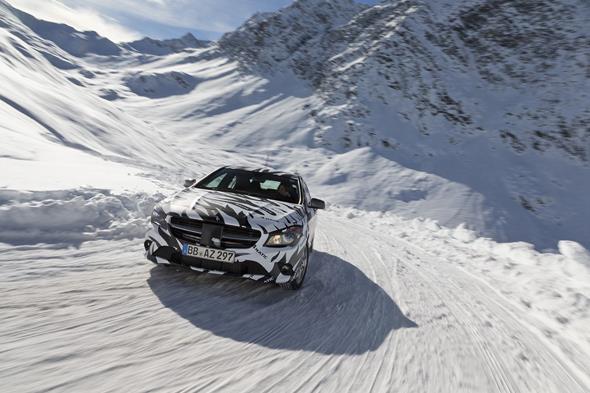
Perfect power transmission is ensured in the CLA 45 AMG thanks to the AMG SPEEDSHIFT DCT 7-speed sports transmission with dual clutch technology and performance-oriented all-wheel drive.
The ideal basis for high cornering speeds and exciting, agile handling also comes courtesy of the AMG sports suspension with independently developed front and rear axles, electromechanical AMG speed-sensitive sports steering, AMG high-performance braking system and 3-stage ESP® with “SPORT Handling” mode.
The 3-stage stability programme is also applied to adapt the control strategies of the variable 4MATIC system:
- In “ESP ON” mode a safety-oriented driving programme supports the driver with clear-cut self-steering behaviour, i.e. essentially neutral handling characteristics.
- Briefly pressing the ESP® button activates “ESP SPORT Handling Mode”. This dynamically oriented driving mode applies appropriate control strategies for later ESP® intervention and increased drive torque at the rear axle.
- Pressing the ESP® button longer activates “ESP OFF”. “ESP OFF” should only be used by experienced drivers on cordoned-off race tracks.
After pressing the brake pedal in “ESP SPORT Handling Mode” or “ESP OFF” mode, all ESP® functions are available once again.
Mercedes-Benz CLS 4MATIC Shooting Brake
Elegant in all weathers:
the CLS Shooting Brake in the snow
- CLS Shooting Brake underscores claim to design leadership
- Sports car with five seats and a large tailgate
- In winter, too: stylish sporty performance and superlative driving dynamics
- Tailor-made 4MATIC version for saloons and coupés
- High ride comfort – low fuel consumption
The new CLS Shooting Brake sees Mercedes-Benz making its mark once again with a creative design concept that underscores its leading role in the design field. Surprising yet unequivocally coupé, the CLS Shooting Brake’s proportions create a crouched posture, as if the vehicle were poised to make a leap: long bonnet, narrow window profile with frameless side windows, roof sloping dynamically towards the rear and continuing to the tail end of the vehicle.
It is only when taking a second look that it becomes clear that the Shooting Brake actually has five doors and offers more in terms of function. In essence it represents an unprecedented version of a sports car with five seats and a large tailgate.
It is a special proposition for people looking to differentiate themselves from the mainstream, and who do not wish to compromise on either sportiness or stowage space when it comes to travelling in style.
Like all 4MATIC models from Mercedes-Benz, the high-powered and high-torque CLS 350 CDI 4MATIC (195 kW/265 hp, 620 Nm) and CLS 500 4MATIC (300 kW/408 hp, 600 Nm) feature a permanent all-wheel drive system which guarantees optimum traction and the best possible agility and safety – particularly in wintry road conditions.
As with the 4MATIC system’s set-up on a dry or wet road, directional stability and, therefore, active safety are paramount at all times when wintry conditions prevail, too. The mechanical principle of the 4MATIC system featuring a 45:55 torque split between the front and rear axles and the multi-disc limited-slip centre differential with a basic locking torque of 50 Nm offer all the right ingredients.
This basic design enables high levels of traction, as the dynamic shift in axle load toward the rear axle that occurs during acceleration is harnessed to deliver more drive torque to the rear wheels. However, the multi-disc differential lock is also able to shift the drive torque between the front and rear axles, varying the split as the road conditions dictate.
Consequently, intervention by the ESP®, 4ETS or ASR electronic control systems can be delayed for as long as possible and the bulk of the drive torque converted into tractive power, even on slippery roads.
All control system interventions go virtually unnoticed, yet drivers still know straight away if they are driving on the limit: in such instances, a yellow warning symbol flashes in the instrument cluster as a highly visible prompt to adapt their driving style to the road conditions.
4MATIC: stable handling on snow and ice
When pulling away in wintry conditions, the 4MATIC models are designed to develop maximum traction. To this end, certain road conditions are automatically detected and the interventions of the 4ETS electronic traction control system adjusted so as to achieve the greatest possible acceleration while minimising wheel slip, ensuring optimum directional stability in the process.
This strategy also allows the vehicle to pull away under the most adverse conditions, such as when one side of the vehicle is on an icy slope (µ‑split) or both wheels on either the front or rear axle have limited grip (µ‑jump).
On twisting roads covered with snow and ice, vehicle stability is primarily controlled by the ASR acceleration skid control system’s regulation of engine torque. The ASR control thresholds are adjusted according to the driving situation based on the vehicle’s longitudinal and lateral dynamic readings as continuously measured by the ESP® sensor system.
If vehicle stability is to be maintained, the longitudinal force when cornering must be controlled by means of engine torque regulation in such a way that there are sufficient reserves of lateral force at all times.
In order to comply with this physical correlation, when cornering on road surfaces with a low friction coefficient the control thresholds for engine torque regulation at the wheels on the outside of the bend are reduced considerably so that the tyres can develop sufficient lateral force.
4MATIC: cutting-edge technology breaks new ground
The 4MATIC powertrain fitted in Mercedes-Benz passenger cars is one of the best-performing permanent all-wheel drive systems on the market. The basic design concept, with the engine installed longitudinally and the integral transmission and transfer case unit, produces a compact, lightweight arrangement that minimises frictional losses, heralding a number of benefits compared to other passenger car.
Depending on the particular model, fuel consumption, for instance, is a mere 0.2 to 0.6 litres more per hundred kilometres than on an equivalent vehicle with conventional drive, while vibration and acoustic comfort meet the high standards expected of Mercedes-Benz vehicles.
CLS 4MATIC Shooting Brake: stylish sportiness and dynamism in the winter too
Mercedes-Benz achieves the standard of driving dynamics which the CLS is renowned for courtesy of the highly sophisticated DIRECT CONTROL suspension with adaptive shock absorbers.
The weight-optimised DIRECT CONTROL system, featuring a three-link front suspension and multi-link independent rear suspension, automatically adapts to the changing driving situation by varying the damping forces, resulting in a substantial improvement in ride comfort.
The air suspension system – optional for the CLS 350 CDI 4MATIC BlueEFFICIENCY and standard on the CLS 500 4MATIC BlueEFFICIENCY – is combined with a continuously variable, electronically controlled damping system that processes a series of sensor signals and controls each wheel individually.
So, not only do Mercedes customers experience the best in comfort, they reap the benefits of excellent handling safety and sporty agility too.
GL- and GLK-Class
Effortless superiority on- and off-road
- GL-Class: seven-seater, all-terrain S-Class
- ON&OFFROAD package: innovative dynamic handling control system
- Winter driving mode for added driving pleasure and enhanced safety
- GLK-Class: compact SUV in a new outfit
- Offroad Engineering package broadens horizons
- Pinnacle of perfection with trailblazing assistance systems
The new GL-Class which has been available since November 2012 is the pinnacle of perfection in the ATV and SUV world. It offers a luxurious interior with seven full-size seats and superlative ride comfort accompanied by highly dynamic performance on dry, wet or wintry roads.
The premium SUV also boasts outstanding off-road capabilities, thanks to new suspension developments and innovative dynamic handling control systems which enhance both driving pleasure and safety on the road. In a nutshell, the GL-Class is a seven-seater, all-terrain S-Class.
The optional ON&OFFROAD package for the new GL-Class uses six different driving modes to optimise driving dynamics and handling safety by providing the optimum drive control needed to cope with the wide spectrum of operating conditions encountered both on and off the road.
Drivers have the choice of an automatic mode, two specially programmed off-road modes as well as three
on-road modes – “Winter”, “Sport” and “Towing”.
The specific driving modes for all-wheel drive resolve a conflict of objectives that has previously hampered further development of 4MATIC and the 4ETS electronic traction system as well as ESP® and acceleration skid control (ASR).
To take an example: on off-road tracks or snow-covered roads, it is important that the control systems respond very gently due to the low friction coefficients, but this makes a sporty set-up virtually impossible. Conversely, a sporty basic setup impairs performance abilities in off-road terrain and snow.
In the past, excellent compromises were always found which worked brilliantly under all conditions. The new ON&OFFROAD package with its specific driving modes, however, enables driving dynamics and handling safety to be optimised almost as far as is physically possible under all operating conditions by maximising networking between the individual control systems.
In terms of “hardware”, the ON&OFFROAD package comprises an underguard, a two-stage transfer case with low-range ratio, an inter-axle differential lock and enhanced AIRMATIC functionality that allows a maximum ground clearance of 285 millimetres and a fording depth of 600 millimetres.
Winter driving mode: more fun, more safety
The driving mode is chosen using a rotary control on the centre console. To ensure the selected driving mode – in this case “Winter” – is clearly indicated, a special snowflake graphic appears in the instrument cluster, while the COMAND screen shows the GL-Class in a wintry, snow-covered landscape.
The ON&OFFROAD package’s winter driving mode optimises handling on roads affected by snow, ice or freezing rain and when using snow chains, and offers drivers added safety with its well-defined, predictable reactions.
The extensive fine-tuning work carried out focused on further increasing longitudinal traction, at the same time as improving lateral dynamics and handling safety. The development team was able to implement these specifications to impressive effect using targeted control mechanisms in the drivetrain:
- When pulling away with or without the steering turned, the inter-axle lock in the centre differential is triggered earlier in order to increase traction and reduce understeer when accelerating briskly. In parallel to this, the
7G-TRONIC PLUS switches to the “gentler” ECO mode and automatically engages 2nd gear when pulling away to avoid high wheel slip. Finally, a flatter response curve gives the driver more sensitive control over the accelerator pedal. - Maintaining a locking torque that has been set in the centre differential for longer improves handling stability and helps the driver by making the self-steering characteristics more definite.
- Higher ASR slip thresholds when driving in a straight line result in high traction levels as well as safe operation with snow chains with outstanding tractive power.
- ASR slip thresholds lowered when cornering in order to ensure stable handling characteristics at all times as far as is physically possible.
ACTIVE CURVE SYSTEM for safe fun in the snow at its very best
When the ON&OFFROAD package is combined with the ACTIVE CURVE SYSTEM (ACS), a specially programmed winter set-up guarantees dynamic driving pleasure while giving the driver excellent control over the vehicle for a high degree of handling safety.
ACS uses active anti-roll bars at the front and rear axles to compensate for the roll angle of the body through bends, increasing agility and driving pleasure in the process. At the same time, the system is capable of giving the vehicle greater traction, especially in wintry road conditions with low grip levels.
The ACTIVE CURVE SYSTEM “Snow mode” features two control strategies. Firstly, many of the parameters needed for driving on wintry roads are already incorporated into the basic functions, i.e. when the ON&OFFROAD package’s Automatic driving mode is activated.
This means that the system’s reactions to the driver’s steering inputs will be less dynamic on slippery surfaces. External influencing factors, such as fluctuating friction coefficients on roads that are partially covered in ice or snow, are balanced out faster though.
Thanks to this control strategy, the GL becomes far more docile, even if the vehicle switches between moderate oversteer and understeer.
Secondly, the system control for the winter driving mode includes a special control algorithm. In just the same way as the shaped skis thrill alpine skiers by closely following the desired line even through turns with a tight radius, the car handles in tight bends in this mode.
This control strategy produces increased traction on snow-covered road surfaces by dynamic displacement of the wheel loads. If the driver turns into a tighter bend while travelling at a constant speed or accelerating, the wheel load and, as a result, the traction will be increased at the front wheel on the outside of the bend.
Doing so minimises the understeer that is otherwise typical in this driving situation. If the driver then reduces the steering angle when exiting from the bend while travelling at a constant speed or accelerating, the load at the rear wheel on the outside of the bend will be raised instead.
This has the effect of increasing lateral support at the rear axle, so that the vehicle’s handling is stabilised in the same way as when entering the bend. This time though, it is the tendency to oversteer that is countered.
GLK: Rock-solid character in a fresh guise
Following the world premiere in April 2012, the new Mercedes-Benz GLK is displaying its fresh guise. Its claim to leadership of the compact SUV segment is underscored by trailblazing assistance systems, engines matching efficiency with agility and an extended range of equipment and appointments.
The newly designed exterior lends the GLK added dynamism. The body combines classic elements of all-terrain vehicles with the design idiom of the current Mercedes-Benz models. Stringent lines, expansive surfaces and the smooth-surfaced, volume-emphasizing front and rear areas harmonise with the hallmark GLK body features which are typical of classic, functional all-terrain vehicles.
Apart from the attendant benefits in off-road terrain, this design also offers concrete advantages in day-to-day use. The high seat position provides a commanding view of the traffic situation, with the body lines also designed for excellent visibility.
More possibilities with Offroad Engineering package
The 4MATIC on the GLK is based on the version featuring on the C-, E-, CLS- and S-Class, whereby its outstanding off-road capability sets it apart from the saloons and coupés, however. For keen off-road enthusiasts, an Offroad Engineering package is additionally available to further broaden the scope for off-road adventures.
At the touch of a button a special drive programme is started which varies the shift points of the 7G-TRONIC, “softens” the accelerator characteristics and activates the ESP® off-road functions with off-road ABS and a special off-road 4ETS system.
An additional switch activates Downhill Speed Regulation (DSR), which automatically maintains a preset speed between 4 and 18 km/h on steep downhill stretches. The driver is able to vary the speed at any time by means of the cruise control lever.
Assistance systems familiar from the S- and E-Class feature as standard to enable a further improvement in active safety and driver-fitness safety and take the compact SUV to the top of its market segment.
Electric steering with STEER CONTROL, which supports the driver in unstable driving conditions by triggering an impulse which can be felt on the steering wheel, prompting countersteering by the driver in the correct direction, Brake Assist (BAS), which provides additional brake power when emergency braking is detected, and ADAPTIVE BRAKE featuring Hill-Start Assist, HOLD function, brake drying in the wet and priming of the brake system all support the driver.
The high standard of active safety is ensured by the AGILITY CONTROL suspension with selective damping system, the ESP® Electronic Stability Program with integrated trailer stabilisation and tyre pressure loss warning and, on the 4MATIC models, by permanent all-wheel drive and the 4ETS electronic traction system (except 4×2 models).
Optional equipment: 360°-camera and Active Parking Assist
Optional equipment includes the ATTENTION ASSIST drowsiness detection system and the PRE-SAFE® anticipatory safety system. Additional assistance systems, including active variants, are optionally available. One example here is Active Parking Assist, enabling automatic manoeuvring into and out of parking spaces.
To facilitate manoeuvring when visibility is poor there is a backup camera with guide lines or – for the first time from Mercedes-Benz – a 360° camera. Additional systems are optionally available as individual items or in special packages.
The Driving Assistance package Plus comprises DISTRONIC PLUS including BAS PLUS, PRE-SAFE® Brake, Active Lane Keeping Assist and Active Blind Spot Assist. The Parking package combines the described 360° camera including Active Parking Assist and PARKTRONIC.
The Lane Tracking package includes Lane Keeping Assist and Blind Spot Assist. Another new development is the Offroad Engineering package in combination with the Intelligent Light System. Offroad Light is available here for trips in difficult terrain. Specific headlamp settings provide for better off-road orientation by more widespread illumination of the field of vision.

